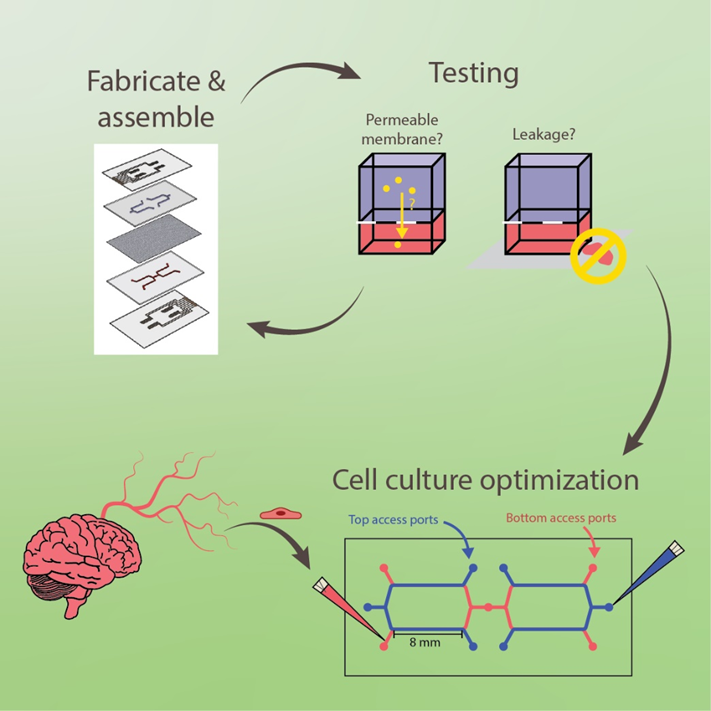The blood-brain barrier (BBB) is involved in many diseases of the central nervous system such as Alzheimer’s disease and Parkinson’s disease [1]. Due to its tightness, the BBB also hinders uptake of drugs into the brain tissue, therefore complicating treatment of such diseases [2].
Organs-on-chips (OoC) are used to model the BBB in vitro to get a better understanding of the changes to the barrier properties in disease, and how drugs can be delivered across the BBB for treatments. However, current BBB-on-chips fail to recapitulate the physiological size and microenvironment of blood vessels in the brain.
A major limitation of many existing OoC models is the low throughput. In order to be useful for drug testing, a high number of samples need to be run in parallel. Therefore, multiplexing of OoCs is a highly relevant challenge. Additionally, the incorporation of sensors directly into the chips allows for online monitoring of various cell culture parameters. For a BBB, its barrier function is of particular interest. Electrodes for measuring the transendothelial electrical resistance (TEER) are a great option for the continuous monitoring of the endothelial barrier tightness [3].
The aim of this project is to optimize the fabrication of a quadro-channel BBB-on-chip which allows the testing of four different conditions in parallel. The work is based on a project started by Mariia Zakharova ([4] - Chapter 5).

During this project you will
- Use SolidWorks (or another CAD program) to modify the chip design.
- Use a micromill to fabricate chip molds from PMMA.
- Use soft-lithography to create microfluidic chips from PDMS.
- Assemble the chips and test them for leakage and membrane permeability.
- Experiment with different fabrication approaches to achieve leakage-free chips with permeable membranes.
- Conduct impedance measurements to assess the functioning of the integrated electrodes.
- Optimize cell culture inside the chips and measure TEER development over time
References
[1] M. D. Sweeney, A. P. Sagare, and B. V. Zlokovic, “Blood–brain barrier breakdown in Alzheimer disease and other neurodegenerative disorders,” Nature Reviews Neurology, vol. 14, no. 3, pp. 133–150, Mar. 2018, doi: 10.1038/nrneurol.2017.188.
[2] W. M. Pardridge, “Drug Targeting to the Brain,” Pharmaceutical Research, vol. 24, no. 9, pp. 1733–1744, Sep. 2007, doi: 10.1007/s11095-007-9324-2.
[3] M. A. Holzreuter and L. I. Segerink, “Innovative electrode and chip designs for transendothelial electrical resistance measurements in organs-on-chips,” Lab Chip, pp. 1121–1134, 2024, doi: 10.1039/D3LC00901G.
[4] M. Zakharova, “Engineering a multiplexed Blood-Brain Barrier-on-a-chip,” University of Twente, Enschede NL, 2022. [Online]. Available: 10.3990/1.9789036554299
